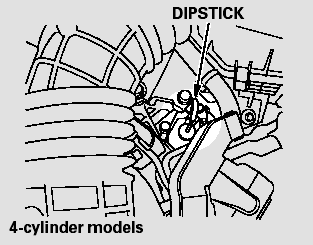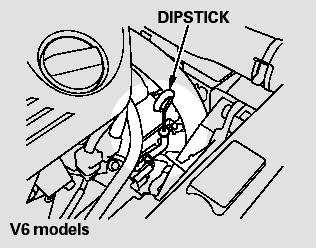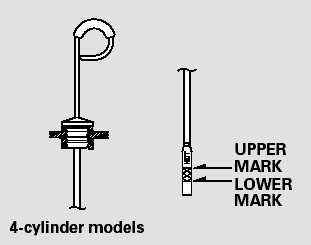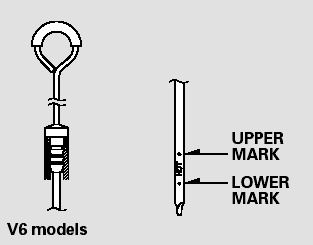 Honda Accord: Automatic Transmission
Honda Accord: Automatic Transmission

Check the fluid level with the engine at normal operating temperature.
1. Park the vehicle on level ground.
Start the engine, let it run until the radiator fan comes on, then shut off the engine. For accurate results, wait about 60 seconds (but no longer than 90 seconds) before doing step 2.

2. Remove the dipstick (yellow loop) from the transmission, and wipe it with a clean cloth.

3. Insert the dipstick all the way into the transmission securely as shown in the illustration.

4. Remove the dipstick and check the fluid level. It should be between the upper and lower marks.
5. If the level is below the lower mark, add fluid into the dipstick hole to bring it to the level between the upper and lower marks.
Pour the fluid slowly and carefully so you do not spill any. Clean up any spill immediately; it could damage components in the engine compartment.
Always use Honda ATF DW-1 (automatic transmission fluid).
6. Insert the dipstick all the way back into the transmission securely as shown in the illustration.
The transmission should be drained and refilled with new fluid according to the Maintenance Minder TM.
If you are not sure how to add fluid, contact your dealer.

Use only Honda ATF DW-1 (automatic transmission f luid). Do not mix with other transmission f luids.
Using transmission f luid other than Honda ATF DW-1 may cause deterioration in transmission operation and durability, and could result in damage to the transmission.
Damage resulting from the use of transmission f luid other than Honda ATF DW-1 is not covered by the Honda new vehicle warranty.
 Manual Transmission
Manual Transmission
4-cylinder models
Check the fluid level with the
transmission at normal operating
temperature and the vehicle sitting
on level ground.
To check the transmission fluid level,
remove the und ...
See also:
Grab Handle Removal/Installation
Special Tools Required
KTC Trim Tool Set SOJATP2014*
*Available through the Honda Tool and
Equipment
Program; call 888-424-6857
NOTE:
- Use the appropriate tool from the KTC trim tool set to
a ...
A FewWordsAbout Safety
Your safety, and the safety of others,
is very important. And operating this
vehicle safely is an important
responsibility.
To help you make informed
decisions about safety, we have
provide ...
Steering Angle Sensor Replacement
SRS components are located In this area. Review the SRS component locations:
4-door (see page 24-21), 2-door (see
page 24-23) and the precautions and procedures (see page 24-25).
NOTE: Do not da ...

